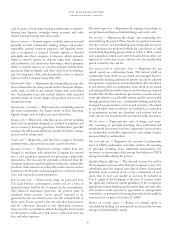American Express 2008 Annual Report Download - page 60
Download and view the complete annual report
Please find page 60 of the 2008 American Express annual report below. You can navigate through the pages in the report by either clicking on the pages listed below, or by using the keyword search tool below to find specific information within the annual report.2008 financial review
american express company
cash in excess of near-term funding requirements in interest-
bearing time deposits, overnight sweep accounts, and other
interest bearing demand and call accounts.
Interest expense — Interest expense includes interest incurred
primarily to fund cardmember lending, charge card product
receivables, general corporate purposes, and liquidity needs,
and is recognized as incurred. Interest expense is divided
principally into three categories (i) deposits, which primarily
relates to interest expense on deposits taken from customers
and institutions, (ii) short-term borrowings, which primarily
relates to interest expense on commercial paper, federal funds
purchased, bank overdrafts, and other short-term borrowings,
and (iii) long-term debt, which primarily relates to interest
expense on the Company’s long-term debt.
Cardmember loans — Represents the outstanding amount due
from cardmembers for charges made on their American Express
credit cards, as well as any interest charges and card-related
fees. Cardmember loans also include balances with extended
payment terms on certain charge card products and are net of
unearned revenue.
Cardmember receivables — Represents the outstanding amount
due from cardmembers for charges made on their American
Express charge cards as well as any card-related fees.
Charge cards — Represents cards that carry no pre-set spending
limits and are primarily designed as a method of payment and
not as a means of financing purchases. Cardmembers generally
must pay the full amount billed each month. No finance charges
are assessed on charge cards.
Credit cards — Represents cards that have a range of revolving
payment terms, grace periods, and rate and fee structures.
Discount revenue — Represents revenue earned from fees
charged to merchants with whom the Company has entered
into a card acceptance agreement for processing cardmember
transactions. The discount fee generally is deducted from the
Company’s payment reimbursing the merchant for cardmember
purchases. Such amounts are reduced by contra-revenue such as
payments to third-party card issuing partners, cash-back reward
costs, and corporate incentive payments.
Interest-only strip — Interest-only strips are generated from
U.S. Card Services’ securitization activity and are a form of
retained interest held by the Company in the securitization.
This financial instrument represents the present value of
estimated future positive “excess spread” expected to be
generated by the securitized assets over the estimated life of
those assets. Excess spread is the net cash flow from interest
and fee collections allocated to the third-party investors’
interests in the securitization after deducting the interest paid
on the investor certificates, credit losses, contractual servicing
fees, and other expenses.
Merchant acquisition — Represents the signing of merchants to
accept American Express-branded charge and credit cards.
Net card fees — Represents the charge card membership fees
earned during the period. These fees are recognized as revenue
over the covered card membership period (typically one year),
net of provision for projected refunds for cancellation of card
membership. Beginning prospectively as of July 1, 2006, certain
card acquisition-related costs were reclassified from other, net
expenses to a reduction in net card fees over the membership
period covered by the card fee.
Net interest yield on cardmember loans — Represents the net
spread earned on cardmember loans. Net interest yield on
cardmember loans (both on an owned and managed basis) is
computed by dividing adjusted net interest income by adjusted
average loans, computed on an annualized basis. The calculation
of net interest yield on cardmember loans (both on an owned
and managed basis) includes interest and fees that are deemed
uncollectible. For the owned basis presentation, reserves and net
write-offs related to uncollectible interest and fees are recorded
through provisions for losses – cardmember lending, and for the
managed basis presentation, reserves and net write-offs related
to uncollectible interest and fees are included as a reduction
to securitization income, net; therefore, such reserves and net
write-offs are not included in the net interest yield calculation.
Net loss ratio — Represents the ratio of charge card write-
offs consisting of principal (resulting from authorized and
unauthorized transactions) and fee components, less recoveries,
on cardmember receivables expressed as a percentage of gross
amounts billed to cardmembers.
Net write-off rate — Represents the amount of cardmember
loans or USCS cardmember receivables written off consisting
of principal (resulting from authorized transactions), less
recoveries, as a percentage of the average loan balance or USCS
average receivables during the period.
Qualified Equity Offering — The sale and issuance for cash by
the Company to persons other than the Company or any of its
subsidiaries after the original issue date of shares of perpetual
preferred stock, common stock or any combination of such
stock, that, in each case, qualify as and may be included in
Tier 1 capital of the Company at the time of issuance under
the applicable risk-based capital guidelines of the Company’s
appropriate federal banking agency (other than any such sales
and issuances made pursuant to agreements or arrangements
entered into, or pursuant to financing plans which were publicly
announced, on or prior to October 13, 2008).
Return on average equity — Return on average equity is
calculated by dividing one year period net income by one year
average total shareholders’ equity.
58
























